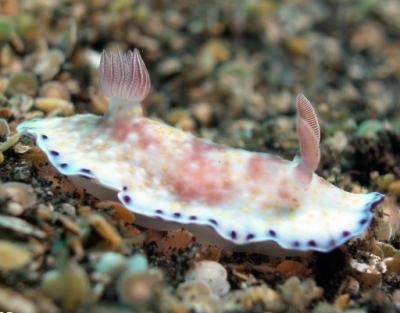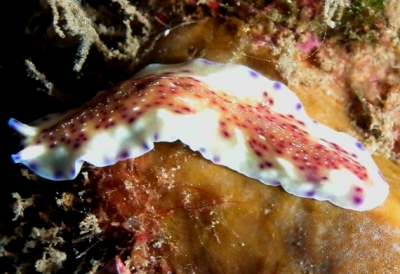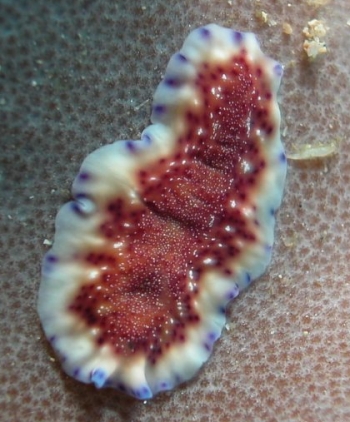Re: Mantle flaring in Chromodorididae
June 4, 2008
From: Teresa Zuberbühler


Concerning message #2566:
Dear Bill
I have seen mantle flapping quite often in the following species: Chromodoris aureopurpurea, Chromodoris coi, Chromodoris kuniei.
My private theory is, that the flapping makes the nudibranch looks very much like a flatworm. All these nudibranchs have a colorful edge which is clearly visible when flapping, same as many flatworms.
As an example I send you a picture of two species of flatworms (Pseudoceros cf laingensis [lower photo] and Pseudoceros sp.7[middle photo]) that looks like Chromodoris aureopurpurea. These flatworms are found mostly in corals reefs, not sandy areas.
Locality: Indonesia, Pacific, 2003 to 2006, Reef. Photographer: Teresa (Zubi) Zuberbühler.
Teresa Zuberbühler
webmaster@starfish.ch
Zuberbühler, T., 2008 (Jun 4) Re: Mantle flaring in Chromodorididae. [Message in] Sea Slug Forum. Australian Museum, Sydney. Available from http://www.seaslugforum.net/find/21610
Dear Zubi,
Among the behavioural oddities in nudibranchs, 'mantle flapping' can be one of the most spectacular, with some sending an irregular wave along both sides of the mantle, some just flapping the anterior end, and others raising and lowering the whole of the mantle edge in a single movement. Certainly this can at times look like the waves along the edge of a flatworm's body, but I don't know if we could ever determine whether this waving has evolved to mimic the movement of the flatworm. My feeling [no proof] is that the chromodorids wave the edge of the mantle - which is where they concentrate nasty chemicals - to attract potential predators to the most distasteful and potentially sacrificial parts of their body. Predators would taste the wriggling bits, get a mouthful of nasty chemicals, and leave the rest of the body alone.
An important question when we consider two or more very similarly coloured animals is whether the similarity is just a co-incidence or is one trying to mimic the other? As I discuss on the mimicry Fact Sheet, if mimicry is involved, how do we decide which is the model and which is the mimic? There are certainly many nudibranchs and flatworms which look alike. I am not sure how we are going to discover whether the flatworm or the nudibranch evolved their colour pattern first. Until we know that, we can't really say whether nudibranchs evolved mantle-flapping to look like flatworms, or vice versa. It is an interesting question - just the thing to discuss on a long boat trip home from a dive.
Best wishes,
Bill Rudman
Related messages
-
Mantle flaring in Chromodorididae
From: Ray Izumi, June 15, 2000
